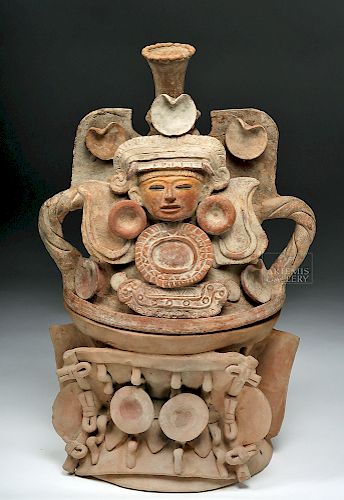Huge Teotihuacan Ceramic Incensario - Top and Bottom
Lot 144b
About Seller
Artemis Fine Arts
686 S Taylor Ave, Ste 106
Louisville, CO 80027
United States
Selling antiquities, ancient and ethnographic art online since 1993, Artemis Gallery specializes in Classical Antiquities (Egyptian, Greek, Roman, Near Eastern), Asian, Pre-Columbian, African / Tribal / Oceanographic art. Our extensive inventory includes pottery, stone, metal, wood, glass and textil...Read more
Estimate:
$18,000 - $27,000
Absentee vs Live bid
Two ways to bid:
- Leave a max absentee bid and the platform will bid on your behalf up to your maximum bid during the live auction.
- Bid live during the auction and your bids will be submitted real-time to the auctioneer.
Bid Increments
| Price | Bid Increment |
|---|---|
| $0 | $25 |
| $300 | $50 |
| $1,000 | $100 |
| $2,000 | $250 |
| $5,000 | $500 |
| $10,000 | $1,000 |
| $20,000 | $2,500 |
| $50,000 | $5,000 |
| $100,000 | $10,000 |
| $200,000 | $20,000 |
About Auction
By Artemis Fine Arts
Feb 21, 2019
Set Reminder
2019-02-21 10:00:00
2019-02-21 10:00:00
America/New_York
Bidsquare
Bidsquare : Exceptional Antiquities, Asian, Ethnographic
https://www.bidsquare.com/auctions/artemis-gallery/exceptional-antiquities-asian-ethnographic-3858
An important one-day auction featuring museum-worthy examples of Egyptian, Greek, Roman, Etruscan, Near Eastern, Far East / Asian, Pre-Columbian, African / Tribal, Oceanic, Native American, Spanish Colonial, Russian, Fossils, Ancient Jewelry, Fine Art, so much more! Artemis Fine Arts info@artemisfinearts.com
An important one-day auction featuring museum-worthy examples of Egyptian, Greek, Roman, Etruscan, Near Eastern, Far East / Asian, Pre-Columbian, African / Tribal, Oceanic, Native American, Spanish Colonial, Russian, Fossils, Ancient Jewelry, Fine Art, so much more! Artemis Fine Arts info@artemisfinearts.com
- Lot Description
Pre-Columbian, Valley of Mexico, Teotihuacan, ca. 150 to 650 CE. A massive incensario (censer), made from molded and applied ceramic, with ornate symbolic artwork on its two separate components, a base for holding whatever was burned to create the incense, and an upper portion with a long spout for releasing the scent into the room. The base is decorated with a dramatic face of Chaac/Tlaloc, the rain deity who had power over fertility and agriculture, and who, as here, is often portrayed with big eyes leaking tears (symbolizing rain) and an inhuman face. Applied strips of clay create a frame around his face, as well as huge earspools; spikes and knots adorn this frame. The rest of the base is hourglass-shaped, with four round holes punched by hand through the upper portion to allow scent to escape. Size of lower portion: 14" W x 8.5" H (35.6 cm x 21.6 cm); size of upper portion: 14.5" W x 13.65" H (36.8 cm x 34.7 cm)
The upper portion is painted, and features a mask-like face of a deity. This figure wears a dramatic, round headdress, two enormous earspools, and a massive round pectoral with a flat portion affixed to its lower end. Two curved handles are at the sides, while a tall, conical spout with a wide mouth rises from behind the face. Applied discs are above the face. White, red, and orange pigment color this fantastical creation.
This censer is known as a "theater type" and is among the most emblematic articles of visual culture of Teotihuacan. These were first created in the Tzacualli period (1 to 100 CE), and during the following years until the demise of Teotihuacan, artisans created more and more intricate compositions. Molds were used to make various ornaments that were glued to the primary body and the plates were arranged in superimposed planes as we see in this example. They are known as "theater" because they seem to represent the architecture of a temple, with the mask at the top representing the deity within the temple.
Numerous scholars have suggested that censers like this example were instrumental to a cult dedicated to warriors killed in combat. Incense played a major role in religious practice in Mesoamerica, from the Olmec onward. Many tombs are outfitted with incensarios and the items also seem to have been used in ceremonies by the living. The incense was made from copal, tree resin from the torchwood tree. By burning copal, Mesoamerican priests made an offering to the gods - for example, during an Aztec ceremony for the god Huitzilopochtli, the hummingbird-formed god of war, priests hoped that their prayers would be carried upward along with the wafting smoke and scent.
Provenance: private Hawaii, USA collection; ex T. Misenhimer, Hollywood Film Producer; ex Sotheby's
All items legal to buy/sell under U.S. Statute covering cultural patrimony Code 2600, CHAPTER 14, and are guaranteed to be as described or your money back.
A Certificate of Authenticity will accompany all winning bids.
We ship worldwide and handle all shipping in-house for your convenience.
#132599Repaired and restored from multiple pieces, with overpainting along the restoration lines. Losses from the sides of the spout. Beautiful remaining pigment.Condition
- Shipping Info
-
All shipping is handled in-house for your convenience. Your invoice from Artemis Gallery will include shipping calculation instructions. If in doubt, please inquire BEFORE bidding for estimated shipping costs for individual items.
-
- Buyer's Premium



 EUR
EUR CAD
CAD AUD
AUD GBP
GBP MXN
MXN HKD
HKD CNY
CNY MYR
MYR SEK
SEK SGD
SGD CHF
CHF THB
THB

















